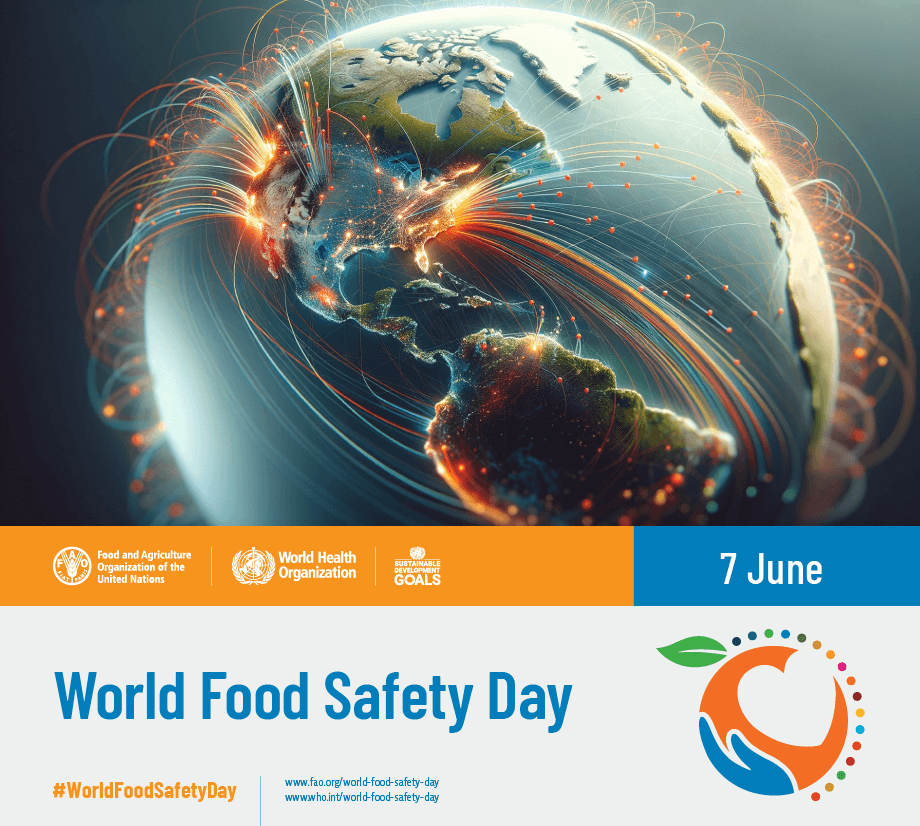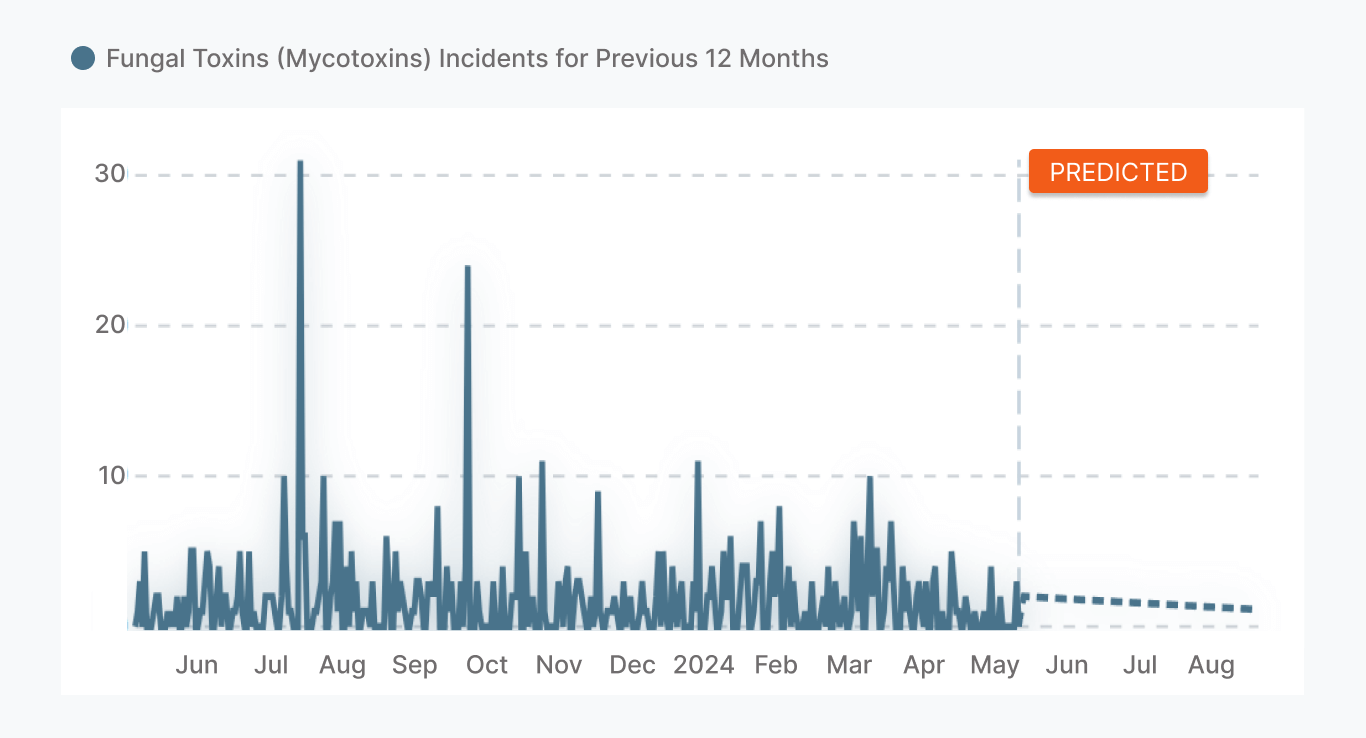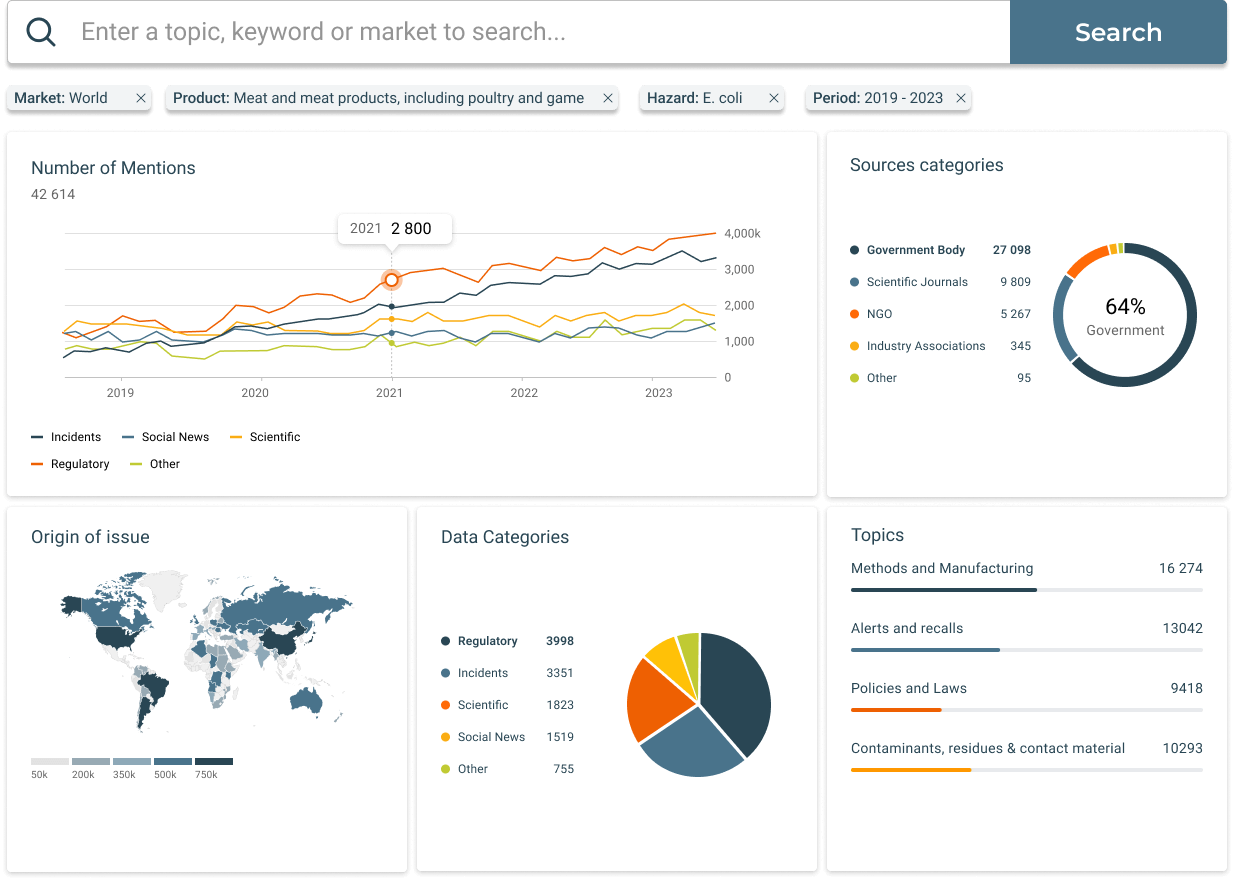June 07, 2024 | Plan, prepare, act!
World Food Safety Day 2024
Welcome to the annual review of global food safety, dedicated to World Food Safety Day 2024. We at SGS Digicomply are excited to join WHO and FAO in sharing valuable insights with the food industry community to help the industry proactively detect and prevent food safety incidents.
Follow and comment our updates on World Food Safety Day!
Food Safety: Prepare for the Unexpected
World Food Safety Day, jointly facilitated by the FAO and WHO, aims to draw attention to and inspire action for preventing, detecting, and managing foodborne risks, contributing to food security, health, and sustainable development.
On June 7, 2024, World Food Safety Day will emphasize the importance of preparedness for food safety incidents, regardless of their severity. These incidents involve potential or confirmed health risks due to accidents, inadequate controls, food fraud, or natural events. Managing these incidents requires efforts from policymakers, food safety authorities, farmers, food businesses, and consumers.

A Historical Look at Food Safety
323 B.C. Alexander the Great
1202: Assize of Bread
1785: Massachusetts Act
1862: Formation of USDA and FDA
1906: Pure Food and Drug Act
1938: Federal Food, Drug, and Cosmetics Act
1949: FDA Toxicity Procedures
1958: Food Additive Amendment
1967: Fair Packaging and Labeling Act
1970: CDC Foodborne Illness Tracking
1973: First Major Food Recall
1977: Food Safety and Quality Service
1996: HACCP Systems Rule
1997: Food and Drug Modernization Act
2000: Global Food Safety Initiative
2002: ESTABLISHMENT OF EFSA
2010: GREEN DEAL INITIATIVE
2011: Food Safety Modernization Act (FSMA)
2020: New Era of Smarter Food Safety
2021: EU FARM TO FORK STRATEGY
Present Day: Continuing Food Safety Challenges
While food safety has advanced greatly since the USDA's inception over 150 years ago, contaminated food still causes illnesses for approximately 600 million people globally each year. Unsafe food results in 420,000 deaths annually. Children under the age of five, who make up only 9 percent of the global population, bear 40 percent of the foodborne disease burden, indicating their heightened vulnerability to foodborne illnesses. It is vital for all involved in food handling to remain vigilant in preventing the spread of harmful microorganisms.
Top Hazards Worldwide
May 2023 - April 2024
-
Salmonella and Listeria monocytogenes: Leading contaminants, indicating persistent challenges in managing bacterial risks in food.
- Mycotoxins (Aflatoxins and Moulds): Significant risks, especially in regions with high humidity, highlighting the need for stringent control measures to mitigate these natural contaminants.
-
Pesticide Residues and Chlorpyrifos: Major issues reflecting ongoing challenges in agricultural practices.
- Misleading and Incomplete Labeling: A critical concern impacting consumer trust and safety.
Comparing Top Hazards in Europe:
May 2022 - April 2023 VS May 2023 - April 2024
(Sourced from RASFF)
- Pesticides: Increase (+5.7%).
- Salmonella: Decrease (-33.2%).
- Adulteration: Reduced (-20.9%).
- Industrial and Environmental Contaminants: Increase (+51.7%).
- Mycotoxins: Slight increase (+1.0%).
- Phytotoxins: Increase (+51.4%).
- Viruses: Rise (+25.4%).
- Food Packaging Contaminants: Decrease (-33.3%).
Worldwide Trend of Mycotoxin Incidents
2010 - 2024 (Sourced from Governmental Bodies)
Following our analysis of food safety hazards, it's evident that mycotoxins have been the fastest-growing concern over the past five years. This is particularly significant given the persistent risks they pose. Between 2017 and 2022, mentions of mycotoxins surged by approximately 1243%, highlighting increasing regulatory and public health attention.
Forecast of Mycotoxin Incidents
for Summer 2024 (Sourced from RASFF)
Despite a slight decrease in 2023, SGS Digicomply Risk Prediction (based on data from the previous 12 months) forecasts a gradual decline in mentions for 2024. This indicates that current control measures may be starting to take effect, but continuous vigilance is essential.

All data in this section is provided by SGS Digicomply, your all-in-one food safety and regulatory compliance software.
Are You Ready to Address Food Safety Incidents?
Key Steps to Enhance Food Safety in Upcoming Year
- Preparedness is Key: Being ready for unexpected food safety incidents is essential. Having robust emergency response plans and strong surveillance systems can make a significant difference.
- Collaborate Effectively: Food safety is a shared responsibility. Coordinated efforts across all sectors — government, industry, and communities — ensure a comprehensive response to food safety issues.
- Share Information Quickly: Rapid and accurate information exchange among all stakeholders, including government agencies, food businesses, and international organizations, is crucial for identifying and addressing food safety events swiftly.
- Communicate Transparently: Maintaining public confidence in the food supply requires providing clear, accurate, and timely information to all stakeholders, including healthcare providers, the media, and the general public.
- Implement Safety Plans: Regularly updating food safety management plans helps protect consumers. Food producers, manufacturers, and retailers must ensure their safety protocols are current and effective.
- Take Decisive Action: Be prepared to implement emergency response strategies, including product withdrawals and recalls. Effective traceability systems help track food through the supply chain, ensuring swift action when needed.
- Use Modern Technologies: Leverage advanced technologies for forecasting and reducing human error, thereby enhancing the accuracy and efficiency of food safety measures.
- Be a Risk Manager: Everyone plays a role in managing food safety risks. From individuals to families, communities, and businesses, making informed choices helps maintain food safety standards.
Innovating for a Safer Tomorrow
On World Food Safety Day, SGS Digicomply reaffirms its dedication to a safe food industry. Food safety knows no borders and faces constant challenges. We innovate to better predict, manage, and mitigate risks, aiming to prevent incidents and ensure every meal is safe. Let's make food safety everyone's priority, together.

FAQ - About World Food Safety Day
- What is World Food Safety Day?
-
World Food Safety Day, observed on 7 June each year, is an initiative jointly facilitated by the Food and Agriculture Organization (FAO) and the World Health Organization (WHO). It aims to draw attention and inspire action to prevent, detect, and manage foodborne risks. This contributes to food security, human health, economic prosperity, and sustainable development.
- Why is World Food Safety Day important?
-
Food safety is critical because unsafe food can cause over 600 million illnesses and 420,000 deaths annually. These incidents, largely preventable, affect everyone from producers to consumers and highlight the importance of food safety throughout the food chain.
- What is the theme for World Food Safety Day 2024?
-
The theme for World Food Safety Day 2024 is "Food safety: prepare for the unexpected." This theme emphasizes the importance of preparedness for food safety incidents, which can range from minor local issues to major international crises.
- When is World Food Safety Day celebrated?
-
World Food Safety Day is celebrated annually on 7 June. It serves as a day to remember the collective responsibility of ensuring safe food and to engage in activities that promote global food safety.
- How can I participate in World Food Safety Day?
-
Individuals and organizations can participate in World Food Safety Day by hosting webinars, engaging on social media, launching food safety campaigns, training staff on food safety practices, and much more. Engaging with the community and spreading awareness are key components of the day.
- Where can I download the World Food Safety Day logo, banner, poster, and other assets?
-
You can download the World Food Safety Day logo, banners, posters, and other assets from the official FAO and WHO resources. Visit the World Food Safety Day digital media assets page for a wide range of communication materials tailored for the event. These resources are designed to help you effectively promote and participate in World Food Safety Day activities.
